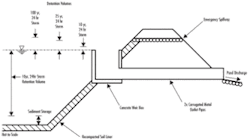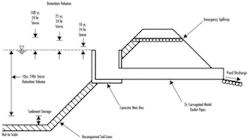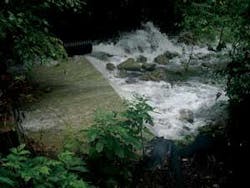Landfill Sediment Pond Design Features Weir Box Outlet
By William M. Strachan and John L. Hattersley
In June 1988 the Ohio legislature passed House Bill 592 as a comprehensive revision to Ohio’s 1976 solid waste law. The scope of House Bill 592 was two pronged: One aspect addressed solid waste planning, including recycling goals and assurance of disposal capacity; the other addressed solid waste landfill permitting, design, and monitoring requirements. With regard to the latter part of the legislation, Ohio EPA was given the task of developing rules that revised solid waste landfill permit requirements to include Best Available Technology.
The Rumpke Brown County Sanitary Landfill near Georgetown, OH, began operating in 1945 and is one of the oldest continuously operating solid waste landfills in Ohio. The first engineering plan for the site was developed in 1976. This plan, which consisted of one 24” x 36” drawing, called for the facility to be constructed and operated as a trench fill below grade and an area fill above grade. While the plan showed the proposed locations and elevations of waste placement, no leachate or surface water controls were detailed. Thus when the facility was required to apply for a permit incorporating Best Available Technology, a number of engineering challenges were presented. One of these challenges was retrofitting surface water control structures to the facility including a sedimentation pond.
Design Development and Approach
Many landfill design practices have been adapted from the highway construction and surface mining industries. This is certainly the case for landfill drainage design. In regards to sedimentation pond design, Ohio EPA’s regulations are similar to surface mining requirements developed in West Virginia and Kentucky.
The general sedimentation design approach followed for the Rumpke Brown County Sanitary Landfill, Best Available Technology permit application was taken from the 1976 U.S. EPA Technology Transfer Seminar Publication, Erosion and Sediment Control: Surface Mining in the Eastern U.S. It also incorporated BMP concepts following the guidelines presented in “Controlling Urban Runoff: A Practical Manual for Planning and Designing Urban BMP’s.”1
Detailed Design Procedures
As a first step in the design of the required control systems, hydrographs and peak runoff volumes were computed for the 10-, 25-, and 100-year, 24-hour storms.
Peak runoff volumes for the 100-year, 24-hour storm were used for the design of two channels to be placed around the perimeter of the landfill to divert runoff into the sedimentation pond. These channels were proposed to be grass lined, thus were designed assuming that vegetation was established because the retardance of the vegetation results in the greatest flow depths.
The required pond volume per Ohio EPA regulations was computed for the 10-year, 24-hour storm. In the design, this volume represents the required pond retention for settling. An analysis of discrete settling using Stoke’s law was followed to determine the minimum pond surface area needed. In this analysis it was assumed that a particle one millimeter in diameter would be the smallest particle that could be removed by settling.2 Next, the sediment pond detention time was calculated and a 94.91% theoretical pond removal efficiency was determined. From these analyses it was determined that the pond, as designed, could accommodate an influent suspended solids concentration of 865 mg/L during a 10 year, 24 hour storm and still meet a 45 mg/L daily effluent suspended solids concentration. The sediment mean event influent suspended solids concentration was estimated to be 275 mg/L. Thus it was concluded that the pond, as designed, would be able to comply with the anticipated discharge limitations for suspended solids.
The sedimentation pond outlet structures were designed to provide for the required storm detention and to meet regulatory requirements.
The principal spillway for the pond was designed to consist of a concrete broad-crested weir box discharging through two corrugated metal pipes. The emergency spillway was designed to consist of a rock-lined trapezoidal channel. During the 10-year, 24-hour storm the hydraulic capacity of the broad-crested weir controls was designed to provide the required detention.
The emergency spillway invert elevation was set such that there would be no flow through the emergency spillway during the 25-year, 24-hour storm. The peak stage of the pond during the 100-year, 24-hour storm was checked to make sure that a minimum one foot of freeboard was provided.
Although not considered in the engineering calculations, several BMP elements were incorporated into the sedimentation pond design. The wet pond design approach is itself a BMP that is recommended for developments larger than 20 acres in size. BMP benefits of a wet pond include peak discharge control, high removal of suspended sediment, and streambank erosion control.
Other BMP elements incorporated into the pond design included a rock-lined aquatic bench at the permanent pool elevation of the pond and two stilling basins or sediment forebays located where each of the two runoff control channels entered the pond.
Conclusion
The Rumpke Brown County Sanitary Landfill sedimentation pond has now been in operation for over 14 years. Monitoring of the pond discharge has shown the design to be effective in meeting all requirements. Recent NPDES monitoring data from September 2006 to September 2008 showed an average effluent suspended solids concentration of 31.1 mg/L.
The Rumpke Brown County Landfill site currently has expansion plans pending permit approval. Due to the effectiveness of the original design, additional sedimentation ponds for the expansion were designed using the same approach as the existing pond.
References
- Schueler, T.R. “Controlling Urban Runoff: A Practical Manual for Planning and Designing Urban BMP’s,” Metropolitan Washington Council of Governments, July 1987.
- Tchobanoglous, G. “Wastewater Engineering: Treatment, Disposal, Reuse, 2nd ed.,” McGraw Hill, 1979.
About the Authors:
William M. Strachan, P.E., is a Senior Engineer with RNK Environmental (Erlanger, KY). John L. Hattersley, P.E., is a Senior Site Engineer with Rumpke Waste Systems (Cincinnati, OH).



